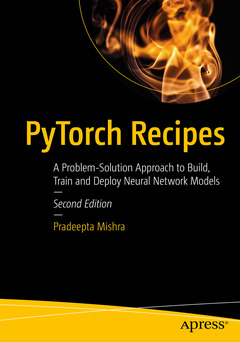Description
PyTorch Recipes (2nd Ed., 2nd ed.)
A Problem-Solution Approach to Build, Train and Deploy Neural Network Models
Author: Mishra Pradeepta
Language: English
Subjects for PyTorch Recipes:
Keywords
PyTorch; Tensors; Neural Networks; Python; CNN; RNN; Supervised Learning; Image Processing; Skorch
266 p. · 17.8x25.4 cm · Paperback
Description
/li>Contents
/li>Biography
/li>Comment
/li>
- Utilize new code snippets and models to train machine learning models using PyTorch
- Train deep learning models with fewer and smarter implementations
- Explore the PyTorch framework for model explainability and to bring transparency to model interpretation
- Build, train, and deploy neural network models designed to scale with PyTorch
- Understand best practices for evaluating and fine-tuning models using PyTorch
- Use advanced torch features in training deep neural networks
- Explore various neural network models using PyTorch
- Discover functions compatible with sci-kit learn compatible models
- Perform distributed PyTorch training and execution
Chapter 1: Introduction to PyTorch, Tensors, and Tensor Operations
Chapter Goal: This chapter is to understand what is PyTorch and its basic building blocks.
Chapter 2: Probability Distributions Using PyTorch
Chapter Goal: This chapter aims at covering different distributions compatible with PyTorch for data analysis.
Chapter 3: Neural Networks Using PyTorch
Chapter Goal: This chapter explains the use of PyTorch to develop a neural network model and optimize the model.
Chapter 4: Deep Learning (CNN and RNN) Using PyTorch
Chapter Goal: This chapter explains the use of PyTorch to train deep neural networks for complex datasets.
Chapter 5: Language Modeling Using PyTorch
Chapter Goal: In this chapter, we are going to use torch text for natural language processing, pre-processing, and feature engineering.
Chapter 6: Supervised Learning Using PyTorch
Goal: This chapter explains how supervised learning algorithms implementation with PyTorch.
Chapter 7: Fine Tuning Deep Learning Models using PyTorch
Goal: This chapter explains how to Fine Tuning Deep Learning Models using the PyTorch framework.
Chapter 8: Distributed PyTorch Modeling
Chapter Goal: This chapter explains the use of parallel processing using the PyTorch framework.
Chapter 9: Model Optimization Using Quantization Methods
Chapter Goal: This chapter explains the use of quantization methods to optimize the PyTorch models and hyperparameter tuning with ray tune.
Chapter 10: Deploying PyTorch Models in Production
Chapter Goal: In this chapter we are going to use torch serve, to deploy the PyTorch models into production.
Chapter 11: PyTorch for Audio
Chapter Goal: In this chapter torch audio will be used for audio resampling, data augmentation, features extractions, model training, and pipeline development.
Chapter 12: PyTorch for Image
Chapter Goal: This chapter aims at using Torchvision for image transformations, pre-processing, feature engineering, and model training.
Chapter 13: Model Explainability using Captum
Chapter Goal: In this chapter, we are going to use the captum library for model interpretability to explain the model as if you are explaining the model to a 5-year-old.
Chapter 14: Scikit Learn Model compatibility using Skorch
Chapter Goal: In this chapter, we are going to use skorch which is a high-level library for PyTorch that provides full sci-kit learn compatibility.
Pradeepta Mishra is the Director of AI, Fosfor at L&T Infotech (LTI), leading a large group of Data Scientists, computational linguistics experts, Machine Learning and Deep Learning experts in building the next-generation product, ‘Leni,’ the world’s first virtual data scientist. He has expertise across core branches of Artificial Intelligence including Autonomous ML and Deep Learning pipelines, ML Ops, Image Processing, Audio Processing, Natural Language Processing (NLP), Natural Language Generation (NLG), design and implementation of expert systems, and personal digital assistants. In 2019 and 2020, he was named one of "India's Top "40Under40DataScientists" by Analytics India Magazine. Two of his books are translated into Chinese and Spanish based on popular demand.
He delivered a keynote session at the Global Data Science conference 2018, USA. He has delivered a TEDx talk on "Can Machines Think?", available on the official TEDx YouTube channel. He has mentored more than 2000 data scientists globally. He has delivered 200+ tech talks on data science, ML, DL, NLP, and AI in various Universities, meetups, technical institutions, and community-arranged forums. He is a visiting faculty member to more than 10 universities, where he teaches deep learning and machine learning to professionals, and mentors them in pursuing a rewarding career in Artificial Intelligence.Is beginner friendly, explaining the step-by-step process for learning and understanding PyTorch
Includes helpful tips and tricks for using PyTorch to train deep learning models
Covers newer topics like distributed PyTorch, sci-kit learn compatibility, and deployment of PyTorch models
These books may interest you

Deep Learning with PyTorch 51.64 €



